Top News
November 8, 2013 Ryukyu Shimpo
Masaru Nakamura of the Okinawa Chura Umi Foundation and other researchers succeeded in converting an adult female fish to a male, for the first time in the world. They managed this by administering a drug that stops the synthesis of female hormones. The foundation announced this world-first achievement on November 7.
Some types of fish change sex as they grow, but in this experiment with an adult fish that does not naturally change its sex, they succeeded in converting ovaries to spermaries. Fishes that change their sex only have female chromosomes, so all of their offspring are female. For this reason, considering that people eat fish eggs or ovaries, the researchers hope to apply the results of their experiment to fish-farming.
A joint paper written by Nakamura and Yoshitaka Nagahama, a professor at Ehime University, appeared in the British scientific journal, Scientific Reports on October 17.
In the experiment, the researchers gave fish food and drugs including aromatase, which stop the synthesis of female hormones. The ovaries changed into spermaries for killifish in about two months and in about six months for tilapia.
A male fish can fertilize three or four female fish, so there being more males is advantageous for breeding. This experiment will contribute to the farming of fish that people eat the eggs and ovaries of, such as herring and mullet. It indicates the possibility of germ stem cells that produce both eggs and sperm, existing in the ovaries. If the researchers preserve ovaries in a frozen state they will be able to restore high-quality varieties that have become extinct and rare species.
Nakamura said, “If the level of female hormones declines, germ stem cells change into sperm. We are also pleased to find where the germ stem cell that changes into either eggs or sperm exists.”
(English translation by T&CT, Mark Ealey)
Go to Japanese
Pros of buying Viagra online:
Wondering why you should buy Viagra online at all? Okay with your current routine that requires regular visits to your doctor in order to get and renew your prescription? Well, looks like you don’t really know what you’re missing. Read on – there’s more to ordering Viagra over the Internet than meets the eye.
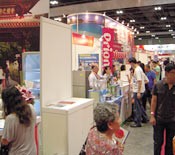
October 29, 2013 Ryukyu Shimpo
According to the Okinawa Prefectural Government, eleven Okinawan companies, including breweries and food processing companies, took part in the Japanese Food Trade Fair “Oishii Japan 2013” held in Singapore from October 17 to 19. They carried out 341 business negotiations during the course of the fair. In a promotion seminar held in the Okinawan booths to introduce kokuto (brown sugar lumps) and mozuku (seaweed), they gave cooking demonstrations using ingredients from the prefecture such as goya (bitter melon), and beni imo (purple yam).
Many buyers commented that Okinawan products are easy to appeal to customers from the perspective of being healthy and aiding longevity, but at the same time, there were also comments that the price is expensive.
On October 18 and 19, ten health food and brewing companies took part in the Dalian China-Japan Trade Investment Exhibition Meeting held to promote Okinawan products.
(English translation by T&CT, Hitomi Shinzato and Mark Ealey)
Go to Japanese
Pros of buying Viagra online:
Wondering why you should buy Viagra online at all? Okay with your current routine that requires regular visits to your doctor in order to get and renew your prescription? Well, looks like you don’t really know what you’re missing. Read on – there’s more to ordering Viagra over the Internet than meets the eye.

November 6, 2013 Yugo Okita of the Ryukyu Shimpo
Okinawa dugong plaintiffs are considering filing a new lawsuit in the United States in an attempt to block the landfill in Henoko, Nago. The governments of Japan and the United States plan to build alternative facilities for U.S. Marine Corps Air Station Futenma at Henoko. The lawsuit aims to make the U.S. government stop the Japanese government from entering the area for the reclamation work. The National Historic Preservation Act (NHPA) of the United States requires its government to protect cultural heritage around the world. If the government’s actions could affect cultural assets in other countries it must take that impact into account.
Based on this law, the plaintiffs are taking action against the U.S. Defense Department in the U.S. District Court in San Francisco in order to protect the dugong as an endangered species. They are requesting that the U.S. Defense Department intervene to stop the Japanese government from going into the U.S. military facilities to construct the new air base.
The plaintiffs, including the Okinawa dugong and three Japanese citizens, as well as six Japanese and American environmental associations have brought another action against Secretary of Defense and the United States Department of Defense for violations of the National Historic Preservation Act. They allege that the defendants approved plans for construction of the Futenma replacement facility without taking into account the effect of the construction of the military facility on the Okinawa dugong, which is a marine mammal of cultural and historical significance to the Japanese people.
The timing of the lawsuit will be decided if the Governor of Okinawa approves the landfill application or if the government seeks execution by proxy in the case that the governor does not approve it. Lawyer Takaaki Kagohashi, the head of the plaintiff attorneys and representative of the Japan Environmental Lawyers Federation, said, “We have to wait to take action until just before the government starts the construction.” He emphasized that because it falls within the authority of the U.S. government, it is possible that the lawsuit in the United States could stop the Japanese government going ahead with the construction by preventing Japanese officials from entering the site.
The plaintiffs are same environmental groups and individuals who filed the Okinawa dugong lawsuit in 2003, which they effectively won. In the interlocutory decision, the judge decided that the dugong is subject to the National Historic Preservation Act, and that the government not evaluating the impact on the dugong was a violation of the law.
Kagohashi said, “We considered protective measures for the dugong in the previous case, but this new lawsuit aims to block the construction involved in the landfill. The American Environmental Law is very strict when it comes to the destruction of the natural environment. Our chances of victory are better in the United States than in Japan.”
(English translation by T&CT, Mark Ealey)
Go to Japanese
Pros of buying Viagra online:
Wondering why you should buy Viagra online at all? Okay with your current routine that requires regular visits to your doctor in order to get and renew your prescription? Well, looks like you don’t really know what you’re missing. Read on – there’s more to ordering Viagra over the Internet than meets the eye.
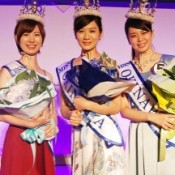
November 3, 2013 Ryukyu Shimpo
The Okinawa Convention & Visitors Bureau held the Miss Okinawa Contest 2014 at the conference center in the Okinawa Convention Center in Ginowan. The contest awarded prizes to winners in three separate categories: 19-year-old college student Keiko Takaesu won Miss Sky Blue, 23-year-old restaurant employee Yui Uehara won Miss Cobalt Blue and 29-year-old company employee Chika Nago won Miss Green Gracious. The three winners will work as goodwill tourism ambassadors for Okinawa from next January, striving to convey the charm of Okinawa to people both inside and outside the prefecture.
From among 76 applicants, they were selected as winners from the 10 contestants who got through to the second audition.
(English translation by T&CT, Mark Ealey)
Go to Japanese
Pros of buying Viagra online:
Wondering why you should buy Viagra online at all? Okay with your current routine that requires regular visits to your doctor in order to get and renew your prescription? Well, looks like you don’t really know what you’re missing. Read on – there’s more to ordering Viagra over the Internet than meets the eye.
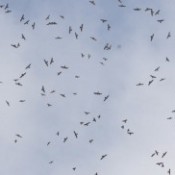
October 29, 2013 Ryukyu Shimpo
On October 28, the Nature Conservation Section of the Okinawa Prefectural Government and the Wild Bird Society of Miyako announced that the number of gray-faced buzzards observed at two spots in Miyako-jima City has reached 31,833. This is the first time since 2008 that the number has exceeded 30,000 and the third time since 1990. On Irabu Island, on October 13 alone they confirmed the existence of 21,343 birds, the highest number among all their daily observations. The reason for this is that Typhoons Fitow and Danas came in quick succession, making the birds in Okinawa Island and the Amami Islands fly southwards all at once.
On Miyako Island, the number of incoming gray-faced buzzards during the period of the survey posted a record-low of 646. Land improvement projects have cut trees down at the survey location in Yuhigaoka (above the Matsubara Cemetery Housing Complex), and the volume of traffic of construction vehicles has increased. These factors have led to a decrease in the number of birds. A spokesperson of the Nature Conservation Section of the government said, “The birds will not be able to come here in these circumstances. Those involved in the construction should change things to preserve some trees.”
(English translation by T&CT, Lima Tokumori and Mark Ealey)
Go to Japanese
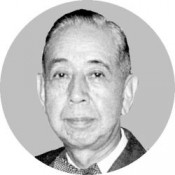
October 31, 2013 Ryukyu Shimpo
Diplomatic documents declassified on October 30 revealed that at his meeting with President Dwight D. Eisenhower in Washington, D.C., on June 1957, then Prime Minister Nobusuke Kishi was to request that administrative rights over Okinawa to be returned to Japan “in ten years.” The documents indicate that Kishi put Okinawa’s return on the summit meeting agenda in addition to talks on revising the Japan-U.S. Security Treaty. These newly declassified documents on Okinawa’s reversion show that Japan estimated that as of 1969 $20 million would be required to cover the relocation for the relay station of the Voice of America (VOA). This became a major issue in later years because in a secret agreement Japan agreed to shoulder the burden of cost to move the station.

Former U.S. President Dwight D. Eisenhower (this photograph by UPI/Kyodo)
Kishi met with President Eisenhower and Secretary of State John Foster Dulles during his visit to Washington, D.C. A memo dated April 1, 1957, created by the Japanese government in the lead up to the summit meeting pointed out that Okinawa’s reversion was a key factor hindering the development of cooperation between the United States and Japan. The memo states that Japan was to put forward a suggestion to resolve the territorial issue, and that based on Article 3 of Treaty of Peace with Japan (San Francisco Peace Treaty), the United States would give up all rights and interests in ten years. There was a handwritten correction of the words “seven years” to read “ten years.”
However, Kishi made no reference to a specific deadline in the talks. The former prime minister indicated that he understood that the U.S. military presence in Okinawa was necessary to ensure security in the Far East, but stated, “I find it difficult to accept the view that we must totally leave (Okinawa’s) administration” to the United States. Kishi suggested that President Eisenhower set a deadline to return Okinawa, saying, (because the U.S. administration of Okinawa remained open-ended) “The Japanese people can’t help feeling uneasy about American intentions.” Eisenhower said that Okinawa would be needed to respond quickly in the case of invasion, suggesting that its return was not an option at that stage.
The Ministry of Foreign Affairs has released 92 books, including 25 books on the reversion of Okinawa. They include records of Japan-U.S. negotiations on the Self-Defense Forces deployment to Okinawa and Operation Red Hat in which poison gas stored in Okinawa was removed to the U.S. territory Johnston Island.
Glossary
Declassified diplomatic documents
In 1976, the Ministry of Foreign Affairs began to declassify some diplomatic documents created more than 30 years earlier. However, many documents have remained classified because their declassification has been left up to the judgment of each department. The previous Democratic Party of Japan (DPJ)-led administration introduced a system in which as a general rule documents older than 30 years will be declassified. This was triggered by the investigation of the U.S.-Japan secret agreement on nuclear weapons. The Liberal-Democratic Party, which returned to power at the end of last year, has also adhered to this policy. The documents will be available for viewing at the Diplomatic Archives in Tokyo after the procedures and declassification review have been completed.
(English translation by T&CT, Mark Ealey)
Go to Japanese

November 4, 2013 Ryukyu Shimpo
On November 2, a couple who were among the first group of emigrants from Okinawa to Bolivia in 1954 came home after 11 years. Ninety-one-year-old Tetsu Nagayama and eighty-eight-year-old Tomiko came back to Okinawa in 1972 before going back to Bolivia in 2002.
Their relatives and about 30 members of the Okinawa Bolivia Association warmly welcomed the couple at Naha Airport. When those waiting for the couple said, “Welcome home!” the husband and wife answered, “It’s good to be back.” Tetsu was so happy that he cried.
After Tetsu led the first Okinawa group of immigrants to Bolivia in 1954 they created farms by reclaiming wilderness areas. Fifteen fellow immigrants went on to die of fevers caused by floods and droughts but they worked hard to develop agriculture by cultivating cassava, rice and soybeans.
When he was back in Okinawa in 1979 Tetsu planted the seeds of South American plants such as floss silk trees sent from Bolivia and worked on a tree-planting campaign in Okinawa.
The couple returned to Bolivia in 2002 but decided to come back to Okinawa once again because of their advancing age. Thanks to the support of Akemi Owan, professor at Okinawa Prefectural College of Nursing who visited Bolivia this September, the couple managed to make their trip back to Okinawa. The husband and wife will move into a nursing home in Tomigusuku.
Tetsu said, “This happy feeling leaves me speechless.” They were thrilled to be reunited with their relatives.
(English translation by T&CT, Mark Ealey)
Go to Japanese

October 31, 2013 Ryukyu Shimpo
Floss silk trees in full bloom in various parts of Okinawa add a slash of color to the prefecture’s streets and towns. Seventy-seven-year-old Naha resident Masahiro Sakumoto enjoys looking at the beautifully formed flowers on a tree in his garden.
The bright pink flowers fascinated people walking by under the blue sky on October 30.
Sakumoto’s father planted the tree more than 50 years ago and has carefully looked after it ever since. Sakumoto said, “Locals sometimes rest under the big tree in summer. Besides the beautiful flowers, the young leaves are also very attractive.” He carefully sweeps up the petals that scatter when the wind blows.
The floss silk tree is native to South America. It is called the southern ocean cherry because its flowers in full bloom are similar to those of a cherry tree.
(English translation by T&CT, Mark Ealey)
Go to Japanese

Go To Video
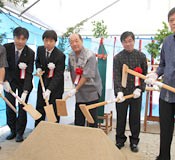
November 1, 2013 Ryukyu Shimpo
On October 31 at Nakaoji in Nago, Orion Beer held a groundbreaking ceremony for the building of mega solar plants in Nago City, Nakijin Village and Itoman City. Orion Beer is the first food and beverage company in Okinawa to start such a solar power generation project. Three mega solar panels will begin operation on April 1, 2014. The initial investment has been about 1.8 billion yen and the company will install about 21,000 Japanese-made panels.
Orion Beer expects a total generation power of the three locations to be five megawatts and power production to be about 5.5 million kilowatts, which is equal to the annual power consumption of about 950 households. The total amount of carbon dioxide emission reduction will be about 4,700 tons, and the power generated will cover half of annual electricity used by the company’s brewery in Nago.
The groundbreaking ceremony in Nago was attended by the president of Orion Beer, Yoshio Kadekaru and other company executives, representatives of the Marubeni Corporation that will undertake the construction and other relevant parties. They all prayed for the construction to go safely. Kadekaru said, “There will be more than 2,000 tons of CO2 emission reductions in Nakaoji.”
Nago Mayor Susumu Inamine said, “Nago aims to become a recycling-oriented society. Orion Beer has its brewery in Nago so we look forward to the project helping our community further develop and prosper.” The company will sell the electricity and expects to earn two billion yen each year.
The service life of electricity generation facilities is about 20 years. Orion Beer expects to recoup the amount invested within ten years and expect the investment efficiency to be five to seven percent.
Orion Beer will install mega solar panels at ground-level in Nago and Nakijin and on the roof of a building in Itoman.
(English translation by T&CT, Megumi Chibana and Mark Ealey)
Go to Japanese
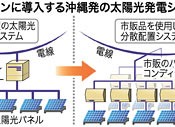
October 31, 2013 Ryukyu Shimpo
From October 31, Okinawa Kobori Electronics will start work on a project to introduce the new utility interactive photovoltaic system that the company has developed to the Solomon Islands in the South Pacific. The Japan International Cooperation Agency commissioned the company to undertake the project. While the current devices collectively control all the solar panels, meaning that the systems of the existing power conditioners may shut down if problems occur, the company’s new system avoids a shutdown by locating the devices decentrally. The new system allows local residents to restore the devices by themselves.
Okinawa Kobori Electronics developed the system in order to cope with typhoon and salt damage and is promoting it in semitropical islands that share the same issues as Okinawa. A representative of the Okinawa International Center said, “We hope that this technology developed in Okinawa will contribute to solving problems faced by island countries and at the same time serve to promote Okinawan companies.”
With design work already underway, the people in charge of the project visited Solomon Islands from October 31 in order to carry out surveys. From June 2014 the company will install a 500-kilowatt system on sites owned by local electric power companies. They signed a contract with the agency on October 25, and are using budget of about 100 million yen available from official development assistance funding.
According to the agency, the islands currently depend mostly on diesel-electric power generation and local electricity charges are about three times higher than those in Japan. The Solomons decided to adopt this system because it will free them from relying on imported energy sources.
According to Okinawa Kobori Electronics, the current mainstream systems could shut down if the power conditioners malfunction. At the moment restoring them can only be carried out by the electronics companies but the system developed by Okinawa Kobori Electronics avoids a shutdown by connecting their power conditioners to every ten-kilowatt photovoltaic panels. It is easy and cheap to use and protects the power conditioners because the company has already developed the device, which it successfully trialed several years ago. It was not mainstream in the industry to start with, but has gradually become widespread. Okinawa Kobori Electronics has already installed this photovoltaic system in Laos three years ago.
The person in charge of the project said, “We want to take this opportunity to boost our business overseas including in emerging countries.”
(English translation by T&CT, Mark Ealey)
Go to Japanese
November 1, 2013 Ryukyu Shimpo
On November 1, it was revealed that an HH-60 rescue helicopter belonging to Kadena Air Base may have dropped its mounted camera during training. According to the Okinawa Defense Bureau, after returning from a flight training exercise U.S. military personnel realized that the camera was not attached. The military did not specify when the accident occurred. The same type of helicopter crashed at Camp Hansen in Ginoza on August 5, killing one crewmember.
According to the defense bureau, the camera measures about 5 cm by 6 cm by 9 cm and weighs 0.5 kg. Because after the helicopter took off from Kadena Air Base and passed over the sea before entering the training area the defense bureau speculates that the helicopter may have dropped the camera either in the Central Training Area or in the sea. While the defense bureau has not been notified by the U.S. military of the date, the military did comment that the helicopter left the base at 3:38 p.m. and returned to Kadena at 6:00 p.m. that same day.
On October 30, the defense bureau requested that the U.S. military take steps to prevent a recurrence and to investigate the cause, as well as to convey this information to the Okinawa Prefectural Government and the relevant municipalities. A spokesperson for the Okinawa Prefectural Government said, “We have not received reports of any damage. We are considering how to respond, including lodging a protest with the U.S. military after we have collected more information.”
(English translation by T&CT, Mark Ealey)
Go to Japanese











 Webcam(Kokusai Street)
Webcam(Kokusai Street)


